#seminal book
Explore tagged Tumblr posts
Text

was lucky to find a cheap copy of this on ebay for $15 given that most of the ones online are around $30-$50. anyway can't wait for it to get here. will post excerpts
#allegedly reading#i got a couple of the seminal texts that are being shared around too like the hundred years' war on palestine#hill and plitnick's except for palestine and noam chomsky's fateful triangle#but i haven't seen anyone talk about sara roy's books and she seems to be a very reputable source
7 notes
·
View notes
Text
i do think it is incredibly funny that like. there is concrete discourse to be had about tbp's production as a rock record made in 2006 where music was still collectively dealing with the loudness war (personally i think it could be soooo much worse and creates a sense of space that gives more fullness than a lot of uber compressed albums). but the second someone says "it's too clean!!" which in turn would make it unemotional/a sellout/less visceral/etc like okay. i simply cannot have this discussion you know nothing
#guys this book is really fun but also do you ever get mad that people dont know anything about music in what is obstensibly a community#about music. haha. yeah im fine#also sorry for making everything abt my chemical romances seminal record the black parade. so pussywhipped im hung up on my girls haters 😝#my posts
13 notes
·
View notes
Text
i know im always like "what if i reread x" and then i dont. but truly honest to god i started telling someone abt WOME and my heart aches for hester shaw. fever too, even. Caul... Maybe everyone actually. even pennyroyal...
#i cant reread it rn bc of school but godddd seminal books. seminal books.#rickyisms#i also feel like im soooo out of touch w the fanbase i'll start posting and be DUMB!!!
0 notes
Text
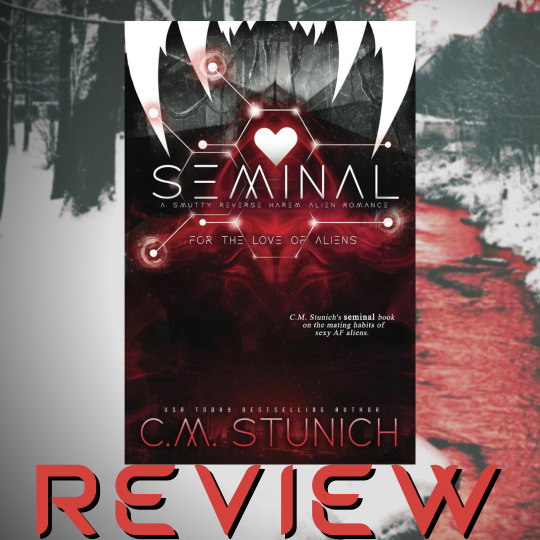
#book review#book reviewer#book blog#book blogger#book influencer#cm stunich#seminal#for the love of aliens#5 star review#five star review#book series#romance series#dark romance#kindle unlimited#alien romance#reverse harem#reverse harem romance#why choose#why choose romance#sci fi romance
0 notes
Text
For example, the maize seedling root system consists of a primary root that develops from the radicle, seminal roots (adventitious roots that branch from the scutellar node), and postembryonically derived crown roots (Figure 19.37).

"Plant Physiology and Development" int'l 6e - Taiz, L., Zeiger, E., Møller, I.M., Murphy, A.
#book quotes#plant physiology and development#nonfiction#textbook#root system#plant roots#maize#corn#zea mays#primary root#seminal roots#crown roots#lateral roots#scutellar node#adventitious roots
1 note
·
View note
Text
noam chomslky has to be an achievement hunter. cant think of any other reason to have his combination of life achievements other than to do and see the following screen pop up
ACHIEVEMENTS GAINIED
piss off everyone in linguistics
write a seminal book in the field of political economy of news media
deny the bosnian genocide
answer 1000000 emails
get a chimpanzee and a video game gnome named after you (less than 0.1% of players have this achievement!)
1K notes
·
View notes
Text
Chaos Magick
Chaos Magick is a modern form of occultism that defies traditional structures and dogmas, embracing a pragmatic, results-oriented approach to magical practice. Unlike conventional magical systems that adhere to specific rituals, symbols, and deities, Chaos Magick emphasizes flexibility, personal belief, and the use of any technique or symbolism that achieves the desired outcome. Originating in the late 20th century, Chaos Magick has become a significant and influential movement within the broader landscape of contemporary occultism, attracting practitioners who value creativity, experimentation, and personal empowerment. This essay explores the history, principles, practices, and significance of Chaos Magick.

History of Chaos Magick
Chaos Magick emerged in the late 1970s and early 1980s as a response to the rigid structures of traditional ceremonial magick and the occult revival movements of the 19th and 20th centuries. The origins of Chaos Magick can be traced to the writings of occultists such as Peter J. Carroll and Ray Sherwin, who were instrumental in developing and popularizing this new approach to magic.
The Influence of Austin Osman Spare:
A significant precursor to Chaos Magick was the work of artist and occultist Austin Osman Spare (1886-1956). Spare's ideas about the subconscious mind, sigils, and the power of belief were highly influential on later Chaos Magicians. He emphasized the use of personal symbols and the manipulation of belief as tools for magical success, laying the groundwork for many of the ideas central to Chaos Magick.
The Birth of the Movement:
In the late 1970s, Peter J. Carroll and Ray Sherwin co-founded the Illuminates of Thanateros (IOT), a magical order dedicated to the practice and development of Chaos Magick. Carroll’s seminal works, "Liber Null" (1978) and "Psychonaut" (1982), became foundational texts for Chaos Magicians. These books outlined the core principles of Chaos Magick, including the emphasis on belief as a tool, the use of sigils, and the concept of "paradigm shifting," where practitioners adopt different belief systems as needed.
Spread and Evolution:
Throughout the 1980s and 1990s, Chaos Magick grew in popularity, particularly in the United Kingdom and the United States. The movement attracted individuals interested in a more personalized and experimental approach to magic, free from the dogmatic constraints of traditional systems. As Chaos Magick evolved, it incorporated influences from psychology, science fiction, pop culture, and postmodern philosophy, reflecting its eclectic and adaptive nature.
Principles of Chaos Magick
Chaos Magick is characterized by several key principles that distinguish it from other forms of magical practice. These principles emphasize flexibility, pragmatism, and the central role of belief in achieving magical outcomes.
Belief as a Tool:
One of the core tenets of Chaos Magick is the idea that belief itself is a powerful tool in magic. Unlike traditional magical systems that require adherence to specific beliefs or deities, Chaos Magick posits that the act of believing—regardless of what is believed—is what makes magic effective. Practitioners are encouraged to adopt and discard beliefs as needed to achieve their desired results, treating belief as a flexible and dynamic tool rather than a fixed truth.
Paradigm Shifting:
Closely related to the use of belief as a tool is the concept of "paradigm shifting." In Chaos Magick, a paradigm is a framework of beliefs, symbols, and practices that a magician temporarily adopts to work a particular spell or ritual. A Chaos Magician might shift between different paradigms—such as using Kabbalistic symbols in one ritual and invoking Lovecraftian deities in another—depending on what they find most effective for their goals. This fluid approach allows practitioners to draw from a wide range of magical and cultural traditions.
Pragmatism and Results-Oriented Practice:
Chaos Magick is inherently pragmatic, focusing on what works rather than adhering to tradition or doctrine. The effectiveness of a magical practice is judged solely by the results it produces. This results-oriented approach encourages experimentation and the development of new techniques, as well as the modification or abandonment of practices that do not yield desired outcomes.
Use of Sigils:
Sigilization, a technique popularized by Austin Osman Spare, is a central practice in Chaos Magick. A sigil is a symbol created by condensing a specific intention or desire into a visual form. The practitioner then uses various methods to "charge" the sigil with energy and launch it into the subconscious mind, where it works to manifest the desired outcome. Sigils are valued for their simplicity and adaptability, making them a popular tool among Chaos Magicians.
The Gnostic State:
Achieving a state of altered consciousness, often referred to as the "Gnostic State" or "gnosis," is a key component of Chaos Magick rituals. This state of mind, in which the practitioner is highly focused and free from distractions, is believed to be crucial for the successful performance of magic. Various methods, such as meditation, chanting, visualization, or sensory deprivation, are used to induce gnosis.
Practices of Chaos Magick
Chaos Magick is known for its eclectic and innovative practices, which can vary widely from one practitioner to another. The following are some of the most common practices associated with Chaos Magick:
Sigil Magic:
As mentioned, sigil magic is a cornerstone of Chaos Magick. The process typically involves creating a sigil by writing out a statement of intent, removing duplicate letters, and arranging the remaining letters into an abstract symbol. The practitioner then enters a Gnostic State, charges the sigil with intent, and either destroys or forgets the sigil to allow it to work subconsciously.
Magical Experimentation:
Chaos Magicians often experiment with a variety of techniques, drawing from different magical traditions, religions, and even pop culture. This might include invoking gods from different pantheons, working with fictional characters as if they were real entities, or incorporating elements of modern technology into rituals. The emphasis is always on what is effective for the individual practitioner.
Deconstructing and Reconstructing Beliefs:
Chaos Magicians regularly engage in the practice of deconstructing and reconstructing their beliefs. By deliberately adopting different belief systems, even those they do not inherently believe in, they explore the effects of belief on reality. This practice often leads to a deeper understanding of the fluid nature of reality and the power of the mind in shaping experience.
Use of Pop Culture and Modern Symbols:
One of the more unique aspects of Chaos Magick is its embrace of contemporary symbols and icons from pop culture. Practitioners might use characters from movies, comic books, or video games as symbols in their rituals, treating these figures as modern-day deities or archetypes. This reflects Chaos Magick's adaptability and its focus on personal relevance over tradition.
Psychological Techniques:
Many Chaos Magicians incorporate psychological techniques into their practice, drawing from fields such as cognitive psychology, NLP (Neuro-Linguistic Programming), and hypnosis. These techniques are used to alter consciousness, influence perception, and reinforce the practitioner’s intent. The integration of psychological methods underscores Chaos Magick's pragmatic and results-driven approach.
Significance and Influence of Chaos Magick
Chaos Magick has had a profound impact on modern occultism, influencing both magical practice and the broader cultural understanding of magic. Its emphasis on flexibility, innovation, and personal empowerment has resonated with a new generation of practitioners who seek a more individualized and adaptive approach to magic.
Democratization of Magic:
One of the most significant contributions of Chaos Magick is the democratization of magical practice. By rejecting rigid hierarchies, dogmas, and the need for formal initiation, Chaos Magick has made occult practices more accessible to a wider audience. Anyone can become a Chaos Magician, regardless of background or experience, as long as they are willing to experiment and learn.
Cultural Impact:
Chaos Magick has also influenced popular culture, particularly in areas related to the occult, science fiction, and the countercultural movements of the late 20th and early 21st centuries. Concepts from Chaos Magick, such as paradigm shifting and the use of pop culture symbols, have found their way into literature, movies, and art, reflecting the movement's broad cultural reach.
Challenges to Traditional Magic:
Chaos Magick challenges the conventional understanding of magic by questioning the necessity of belief in any particular system or deity. This has led to debates within the occult community about the nature of magic, the role of belief, and the effectiveness of traditional practices. Chaos Magick's focus on results over tradition has encouraged many practitioners to rethink their approach to magic.
Influence on Postmodern Thought:
Chaos Magick is often associated with postmodernism, particularly its skepticism of grand narratives and its emphasis on individual experience. The movement’s fluid approach to reality, belief, and identity aligns with postmodern ideas about the constructed nature of reality and the multiplicity of truths. This has made Chaos Magick particularly appealing to those who resonate with postmodern philosophy.
Conclusion
Chaos Magick represents a radical departure from traditional magical systems, offering a flexible, pragmatic, and highly individualized approach to occult practice. By emphasizing the power of belief, the importance of personal experience, and the value of experimentation, Chaos Magick has redefined what it means to practice magic in the modern world. Its influence extends beyond the occult community, challenging cultural and philosophical assumptions about reality, belief, and the nature of power. As a living, evolving tradition, Chaos Magick continues to inspire and empower those who seek to explore the mysteries of existence on their own terms.

#mysticism#occultism#metaphysics#mystic#magick#chaos magick#sigil magick#witchcraft#witchblr#witch#wicca#grimoire#chatgpt
229 notes
·
View notes
Note
You know, it's always struck me as a little odd how little most webcomics actually attempt to adapt to their medium. There's basic strips, the old 2k era 4-square, the endless scroll of Webtoons, and a few weird experimental things like Homestuck, but most webcomics I run into tend to stubbornly stick to conventional portrait-oriented page layouts.
It's… readable, I guess, but that format doesn't seem to work very well for either desktop or mobile viewing. It wastes a lot of screen-space, and usually makes it impossible to actually view the full page without making the text too small to read.
Have you encountered any interesting webcomics that experiment with more landscape-oriented layouts? I'm kinda curious about how well that would work.
So, there's this dude Scott McCloud who wrote about comics in the 90s. His first book, Understanding Comics, is literally the book on comics, it's the one schools make kids read. This third book, Making Comics, is a pretty good practical advice guide I'd recommend, even if it's not his groundbreaking seminal work. In between those two books was one called Reinventing Comics
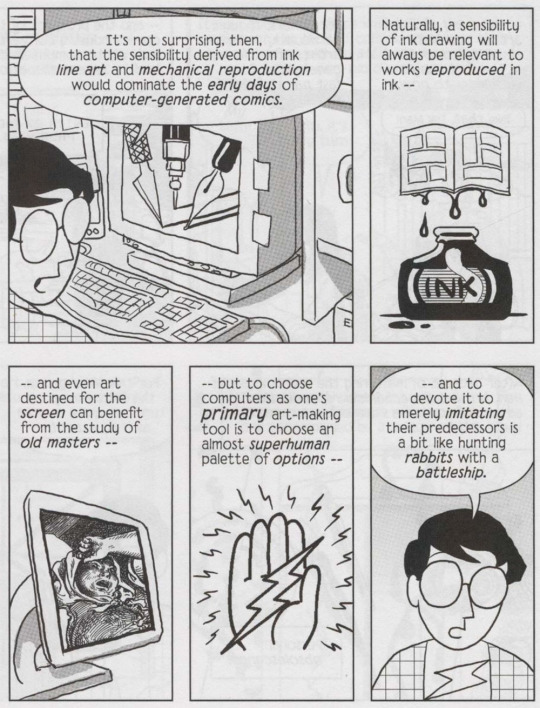
Reinventing Comics, written in 1993, was basically a book of predictions about how this newfangled Interweb was going to revolutionize the art of comics creation. Like a lot of early-90s stuff "Wow the internet!" stuff, it has a lot of inaccurate predictions, and thus isn't super well remembered (though, unlike a lot of early-90s predictions of the internet, it at least vaguely resembled reality).
Anyway, one of the big things from that book was the idea of the "infinite canvas".

Which was basically the idea that a comic didn't have to be constrained by the size of the screen because you could scroll it. And this was a big idea in early webcomics, you heard this phrase a lot. And you'd see infinite canvas techniques like "What if the characters are falling and the comic is really tall to sell that?"

(Read Narbonic)
Which is basically the one and only example that actually took off, because it turns out that scrolling horizontally sucks and no one really wants to do it except as a one-of gimmick (as Homestuck does). The much bigger impact of the internet was that a webcomic could be infinitely long and still reasonably expect it's readership to have read it all, but I think McCloud missed that one. So while there were a bunch of "landscape" webcomics where you scrolled horizontally, none of them took off, and even the ones that were well received are long gone.
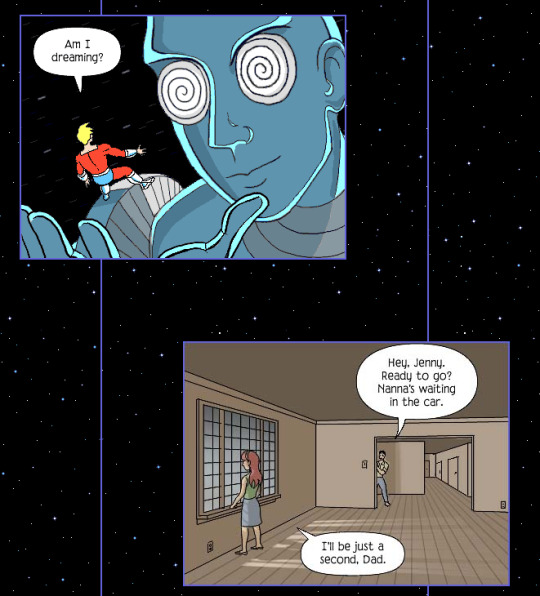
Adams himself would make Zot!, which is a vertical scroll comic that had a bit of a gimmick with parallel story beats being literally parallel. I think he even did some branching paths, and experimented with comics that you could read in different directions or that looped back on themselves.

But then Homestuck just did that better because, as I mentioned, infinite depth ended up being a lot more impactful than infinite width. It turns out that making a comic really wide calls a lot of attention to itself and makes the comic annoying to read. And it doesn't mean you can't do it (Homestuck did it!), but it does mean it can't be the gimmick you hang your comic up on unless you've got a really good reason for doing it.
#Scott McCloud#Homestuck#“Webcomic creators should be more creative”#“What if we made the comic WIDE?”#“Wide is not a creative color”
2K notes
·
View notes
Text
2600’s amazing Hackers on Planet Earth con may go down under enshittification
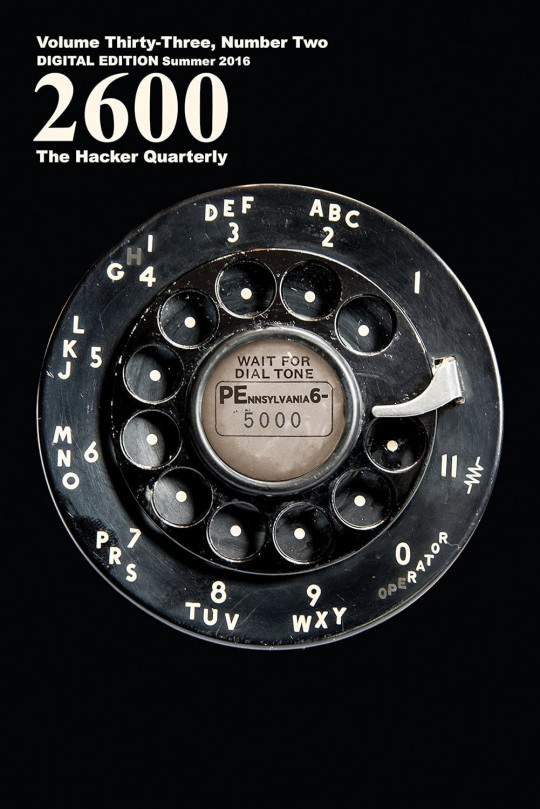
Catch me in Miami! I'll be at Books and Books in Coral Gables on Jan 22 at 8PM.

It's been 40 years since Emmanuel Goldstein launched the seminal, essential, world-changing 2600: The Hacker Quarterly. 2600 wasn't the first phreak/hacker zine, but it was the most important, spawning a global subculture dedicated to the noble pursuit of technological self-determination:
https://www.2600.com/
2600 has published hundreds of issues in which digital spelunkers report eagerly on the things they've discovered by peering intently at the things no one was supposed to even glance at (I'm proud to be one of those writers!). They've fought legal battles, including one that almost went to the Supreme Court:
https://en.wikipedia.org/wiki/DeCSS
They created a global network of meetups where some of technology's most durable friendships and important collaborations were born. These continue to this day:
https://www.2600.com/meetings
And they've hosted a weekly radio show on NYC's WBAI, Off the Hook:
https://wbai.org/program.php?program=76
When WBAI management lost their minds and locked the station's most beloved hosts out of the studio, Off the Hook (naturally) led the rebellion, taking back the station for its audience, rescuing it from a managerial coup:
https://twitter.com/2600/status/1181423565389942786
But best of all, 2600 gave us HOPE – both in the metaphorical sense of "hope for a better technological tomorrow" and in the literal sense, with its biannual Hackers On Planet Earth con:
https://en.wikipedia.org/wiki/Hackers_on_Planet_Earth
For decades HOPE had an incredible venue, the Hotel Pennsylvania (memorialized in the phreak anthem "PEnnsylvania 6-5000"), a crumbling pile in midtown Manhattan that was biannually transformed into a rollicking, multi-day festival of forbidden technology, improbable feats, and incredible presentations. I was privileged to keynote HOPE in 2016:
https://www.youtube.com/watch?v=f1D7APjmVbk
But after the 2018 HOPE, the Hotel Pennsylvania was demolished to make way for the Penn15 (no, really) skyscraper, a vaporware mega-tower planned as a holding pen for luxury shopping and empty million-dollar condos sold to offshore war-criminals as safe-deposit boxes in the sky. The developer, Vornado (no, really) hasn't actually done all that – after demo'ing the Hotel Pennsylvania, they noped out, leave a large, unusable scar across midtown.
But HOPE wasn't lost. In 2022, the ever-resilient 2600 crew relocated to Queens, hosted by St John's University – a venue that was less glamorous that the Hotel Pennsylvania, but the event was still fantastic. Attendance fell from 2,000 to 1,000, but that was something they could work with, and reviews from attendees were stellar.
Good thing, too. 2600 is, first and foremost, a magazine publisher, and these have been hard years for magazines. First there was the mass die-off of indie bookstores and newsracks (I used to sell 2600 when I was a bookseller, and in the years after, I always took the presence of 2600 on a store's newsrack as an unimpeachable mark of quality).
Thankfully for 2600, their audience is (unsurprisingly) a tech-savvy one, so they were able to substitute digital subscriptions for physical ones:
https://www.2600.com/Magazine/DigitalEditions
Of course, many of those subscriptions came through Amazon's Kindle, because nerds were early Amazon adopters, and because the Kindle magazine publishing platform offered DRM-free distribution to subscribers along with a fair payout to publishers.
But then Amazon enshittified its magazine system. Having locked publishers to its platform, it rugged them and killed the monthly subscription fees that allowed publishers to plan for a steady output. Publishers were given a choice: leave Amazon (and all the readers locked inside its walled garden) or put your magazine into the Kindle Unlimited system:
https://www.amazon.com/kindle-dbs/arp/B0BWPTCP4K?deviceType=A1FG5NAKX0MRJL
Kindle Unlimited is an all-you-can-eat program for Kindle, which pays publishers and writers based on a system that is both opaque and easily gamed, with the lion's share of the money going to "publishers" who focus on figuring out how to cheat the algorithm. Revenues for 2600 – and all the other magazines that Amazon had sucked in and sucked dry – fell off a cliff.
Which brings me to the present moment. After 40 years, 2600 is still at it, having survived the bookstorepocalypse, the lunacy of public radio management, the literal demolition of their physical home by an evil real-estate developer, and Amazon's crooked accounting.
This is 2600, circa 2024, and 2024 a HOPE year:
https://www.hope.net/
Once again, HOPE has been scheduled for its new digs in Queens, July 12-14. Last week, HOPE sent out an email blast to their subscribers telling them the news. They expected to sell 500 tickets in the first 24 hours. They didn't even come close:
https://www.2600.com/content/hope-ticket-sales-update
It turns out that Google and the other major mail providers don't like emails with the word "hacker" in them. The cartel that decides which email gets delivered, and which messages go to spam, or get blocked altogether, mass-blocked the HOPE 2024 announcement. Email may be the last federated, open platform we have, but mass concentration has created a system where it's nearly impossible to get your email delivered unless you're willing to play by Gmail's rules:
https://pluralistic.net/2021/10/10/dead-letters/
For Emmanuel Goldstein, founder of 2600 and tireless toiler for this community, the deafening silence following from that initial email volley was terrifying: "like some kind of a "Twilight Zone" episode where everyone has disappeared."
The enshittification that keeps 2600's emails from being delivered to the people who asked to receive them is even worse on social media. Social media companies routinely defraud their users by letting them subscribe to feeds, then turning around to the people and organizations that run those feeds and saying, "You've got x thousand subscribers on this platform, but we won't put your posts in their feeds unless you pay us to 'boost' your content":
https://www.eff.org/deeplinks/2023/04/platforms-decay-lets-put-users-first
Enshittification has been coming at 2600 for decades. Like other forms of oddball media dedicated to challenging corporate power and government oppression, 2600 has always been a ten-years-ahead preview of the way the noose was gonna tighten on all of us. And now, they're on the ropes. HOPE can't sell tickets unless people know about HOPE, and neither email providers nor social media platforms have any interest in making that happen.
A handful of giant corporations now get to decide what we read, who we hear from, and whether and how we can get together in person to make friends, forge community, rabble-rouse and change the world. The idea that "it's not censorship unless the government does it" has always been wrong (not all censorship violates the First Amendment, and censorship can be real without being unconstitutional):
https://pluralistic.net/2022/12/04/yes-its-censorship/
What can you do about it? Well, for one thing, you can sign up for HOPE. It's gonna be great. They've got sub-$100 hotel rooms! In New York City!
https://store.2600.com/products/tickets-to-hope-xv
If you can't make it to HOPE, you can sign up for a virtual membership:
https://store.2600.com/products/tickets-to-hope-xv-virtual-attendee
You can submit a talk to HOPE:
https://www.hope.net/cfp.html
You can subscribe to 2600, in print or electronically (I signed up for the lifetime print subscription and it was a bargain – I devour every issue the day it arrives):
https://store.2600.com/collections/subscriptions-renewals
2600 is living a decade in the future of every other community you care about, weird hobby you enjoy, con you live for, and publication you read from cover to cover. If we can all pull together to save it, it'll be a beacon of hope (and HOPE).
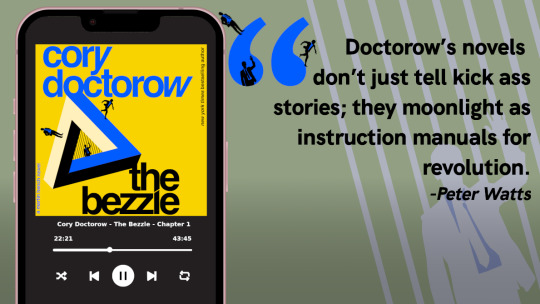
I'm Kickstarting the audiobook for The Bezzle, the sequel to Red Team Blues, narrated by @wilwheaton! You can pre-order the audiobook and ebook, DRM free, as well as the hardcover, signed or unsigned. There's also bundles with Red Team Blues in ebook, audio or paperback.

If you'd like an essay-formatted version of this post to read or share, here's a link to it on pluralistic.net, my surveillance-free, ad-free, tracker-free blog:
https://pluralistic.net/2024/01/19/hope-less/#hack-the-planet
#pluralistic#2600#hackers#magazines#publishing#kindle unlimited publishing#kindle#enshittification#monopoly#end to end#competition#events#nyc#hope#hackers on planet earth#amazon
425 notes
·
View notes
Text
On needing a comprehensive harassment policy
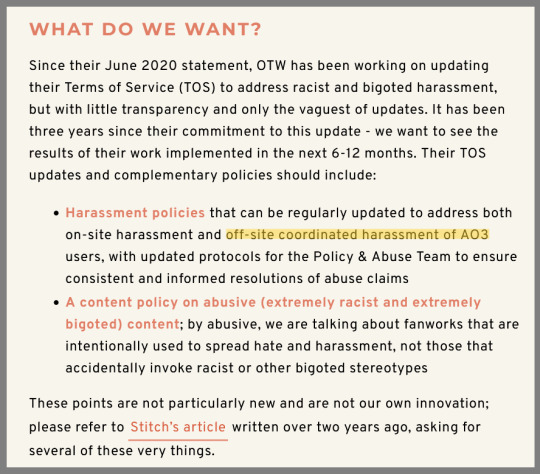
We've been getting some confusion about the part of our demands that talks about OTW needing to consider "off-site coordinated harassment of AO3 users" - which is fair, because I realize that could sound like "OTW needs to monitor/regulate what happens on other platforms" - but that's NOT what we meant by it.
What we meant is: if AO3 users are getting harassed on AO3, and they provide proof in their abuse claim of off-site harassment, that off-site harassment should also be considered as context for making a decision in the abuse claim.
An example of this - which we have permission to share - is what happened to an abuse claim filed by Dr. Rukmini Pande. We won't be linking directly to what happened because we are not trying to target individual users here, but all of what happened is still in public record.
Dr. Pande, a scholar of fan studies who wrote the seminal text on race and fandom, talked on her twitter account a few years ago about a Nazi fic on AO3 that was not only incredibly harmful, offensive, and antisemitic, but where the author had been sending their friends to harass people who criticized the fic. The author proceeded to add a tag to the fic that said "Rukmini Pande Lied About This Fic".
Because Dr. Pande tweeted her criticism from the account with her full name, people said this wasn't doxxing - which is true. But the author of the fic also was tweeting publicly to entertain the idea of reporting Dr. Pande to her employer, and they were also once again sending friends to harass her on Twitter.
When AO3 considered this abuse claim, Dr. Pande provided proof of what was happening on Twitter to show that the author of the fic added the tag of her full name with the intention of inciting harassment to her. But the AO3 Abuse team said that this did not constitute harassment under their TOS.
Cases like that are what we mean by OTW considering "off-site coordinated harassment of AO3 users". Obviously OTW cannot control what is happening on Twitter, or Tumblr, or any other platform. But their Abuse team should be able to consider off-site harassment, when they are given proof of it, in determining whether a case on AO3 is harassment or not.
(Also if you aren't familiar with Dr. Pande's work, her book Squee From The Margins: Fandom and Race is not only fantastic but was the first to comprehensively look at fandom racism, and she also edited a great anthology of articles on race and fandom called Fandom, Now In Color: A Collection of Voices. If you can't afford to buy them, you can request that your local library stock them!)
#seriously check out her books#squee from the margins changed this poster's life#end otw racism#racism in fandom#otw#ao3#endotwracism#archive of our own#organization for transformative works#fandom racism#image descriptions in alt text
2K notes
·
View notes
Text
I posted about it a few days ago, but if you haven’t seen, Steven Attewell, perhaps better known on here as @racefortheironthrone, just passed away.
Steven Attewell wasn’t just a great writer and analyst (though he obviously was), nor just a great podcaster (though he was that too), nor just a great academic mind (though he was that as well). Attewell was a supremely kind, thoughtful, funny, and upstanding human being, someone I was very fortunate to call my dear friend. Hardly a day or two went by without one of us bouncing ideas for an essay or post off the other, or swapping some historical trivia, or sharing thoughts about the latest MCU project. When I got engaged, he was one of the first people I told, and whenever I, say, read a book about New York’s gilded age, or listened to a podcast episode about Reginald Pole, or learned that some Americans were still using hand crank phones into the 80s (no, really), I often thought “Attewell would appreciate that”.
Even now, it seems utterly surreal to think of him as passed. Just a week before he died, I had been telling him how much my fiancé adored his X-Men ‘97 podcast. A few days before, he and I had been joking about the recent east coast earthquake. I knew how excited he was about his “Tyrion IX” ASOS CBC essay, since he and I had been discussing it in the weeks before he died, and his Tumblr posts right to the end displayed that same high quality you could always expect from him. I keep waiting for my messenger app to pop up with his name again, or his familiar avatar to appear at the top of my Tumblr feed with another ask from him.
We have lost a giant of the ASOIAF community, but far more importantly, we have lost a very good person. Read some of Attewell’s works - “Who Stole Westeros” is a seminal piece IMO, as is his CBC analysis of “Eddard XI”, but you can’t go wrong with anything he wrote, and if I tried to list every piece I could recommend from him it would be a novel in itself. Listen to some of his podcasts or vlogs - his excitement over X-Men ‘97 is infectious. Keep reading and writing, just as he was doing. Miss him and grieve, by all means, but know that for the many people, myself included, he inspired and touched and interacted with, his memory and impact won’t be forgotten.
270 notes
·
View notes
Text
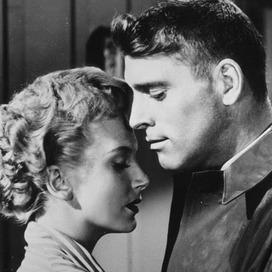

Deborah Kerr and Burt Lancaster (From Here to Eternity, The Gypsy Moths)—no propaganda submitted
Zasu Pitts and Thelma Todd (Let's Do Things, Catch as Catch Can)—[a Vanity Fair article was submitted that was paywalled, so I'm putting the text of it under the cut]
This is round 1 of a mini Christmas tournament. Each poll lasts for three days. If you'd like to send additional propaganda supporting your favorite hot couple, you can reblog this post with your propaganda added, send it to my asks, or tag me in it. To vote in all the polls, click here. Happy holidays!
[additional propaganda under the cut]
Pitts and Todd:
Here is the text of the Vanity Fair article that was submitted, written by Donald Liebenson:
Before Lucy and Ethel, Laverne and Shirley, or Mary and Rhoda, there were Thelma Todd and Zasu Pitts. Separately, they were journeymen character actors in 1930s Hollywood. Together, they became the first major female comedy team, appearing in shorts that found them bonded as friends and career women struggling to make it on their own—the Depression-era answer to Abbi and Ilana of Broad City.
Over a two-year period, they made 17 shorts rarely seen since their theatrical release—and now collected for Thelma Todd & Zasu Pitts: The Hal Roach Collection 1931-33, a two-DVD set. They’re revelatory viewing, progressive, and proto-feminist portrayals of two career girls in the big city, defiantly dependent on each other.
Hal Roach, the legendary producer who teamed up Stan Laurel and Oliver Hardy, envisioned Todd and Pitts as a female equivalent to his marquee stars. Blonde-bombshell Todd was a beauty queen plucked from Massachusetts by a talent scout and brought to Hollywood in the 1920s, where she primarily played comic relief in other people’s films. Kansas-born Pitts was a prolific character actress, so typecast as a comedienne that few directors took her seriously for dramatic roles (though her finest hours were in Erich von Stroheim’s epic, Greed). The contrast between them was more about character than looks. Todd was brash and confident, and Pitts a more dithery presence; think Olive Oyl.
“They have gumption; they’re unflappable,” explained Molly Haskell, film critic and author of the seminal book From Reverence to Rape: The Treatment of Women in the Movies. “They’re looking out for each other; you could just feel the value of the twosome. . . . They are modern women. Hopefully, they will rise to the top—but in the meantime, they’re just going to wing it and figure things out.”
The duo’s first short, Let’s Do Things, establishes their dynamic. Thelma and Zasu promote sheet-music sales in a department store. Pitts moons over her boyfriend, but a disapproving Thelma prompts her to remember why the two came to New York in the first place. “To advance ourselves, to meet the best people, and to do big things,” Pitts responds. By the end of the short, the boyfriend gets a pie in the face, courtesy of Todd.
“They’re always going to have each other’s back,” Haskell noted. “I don’t think there’s any of the shorts where they fight over a man.”
Todd and Pitts’s gender alone made them somewhat revolutionary in their day. Comedy teams were primarily the province of men: the Marx Brothers, the Three Stooges, Laurel and Hardy. “Slapstick was what men loved, and women didn’t because the whole core of it was tearing things up,” Haskell said. “It was chaotic and women wanted order. The defense of the domestic was a woman’s role . . . and slapstick violated the sense of order and decency and uprightness. They didn’t find it funny.”
But Todd and Pitts were both game for the physical stuff. In Let’s Do Things, Todd suffers a throw-about throttling from a quack osteopath; in the courtroom comedy Sneak Easily, juror Pitts throws a murder trial into chaos when she swallows a piece of the evidence—an explosive.
But in their best shorts (which, like the rest of their work, were written and directed by men), the mayhem is mostly in the service of a female narrative, observed film historian Jeanine Basinger. “It’s situational comedy,” she said. “If you’re going to make a plot centered around women, what the heck is she going to do just sitting around the house? They have to get out there in some way. . . . When you look at these films, what you see is what [the creators] thought was a good comedy female situation in that era. You have the chaos over Zasu’s hat in the boxing arena in Catch-as Catch-Can, the high-society party in which they are fish out of water in The Pajama Party, and the department-store melee in The Bargain of the Century. . . . The American woman on film is really a pretty active person, unless she is just stooging it in a male genre. Things have to happen to them, and they have to react. These shorts reflect that very clearly.”
More than 80 years on, the Todd-Pitts shorts play surprisingly well. Their appeal, talent, and chemistry elevate even the most dated material. “I like [Todd and Pitts] so much, and enjoy watching them,” said Leonard Maltin, author of the recently published anthology, Hooked on Hollywood: Discoveries from a Lifetime of Film Fandom and the essential 1970 book Movie Comedy Teams.
“I cannot tell a lie: the shorts are not all good. The gag men had a hard time coming up with suitable material that wouldn’t de-feminize them or make them look outlandishly unladylike, but [Todd and Pitts] play well today because [the characters] aren’t so different from two young women trying to make their way in the world in 2018. The struggles they have by and large tend not to be sexist. If they lose a job, they are comically inept, or it’s a blown opportunity.”
Max and Caroline of 2 Broke Girls, which ran for six seasons on CBS earlier this decade, could be the granddaughters of Thelma and Zasu. Beth Behrs, who played fallen privileged high-society woman Caroline, formed a formidable odd-couple relationship with Max (Kat Dennings), a street-smart waitress trying to start her own cupcake business. Their chemistry, Behrs said, was instant, and their real-life friendship informed their on-screen rapport over the show’s six seasons.
Though the actress was previously unfamiliar with Todd and Pitts, she watched a couple of their shorts on YouTube and saw a kinship with those aspirational woman. “It was important [Caroline and Max] were full-fledged women who really were entrepreneurs,” she said. “We never had a love interest for more than a season. It wasn’t about finding a man; it was about loving each other and building the business from nothing, and the two of them going after the American Dream together.”
For Todd and Pitts, the dream ended when Zasu left the team in 1933. Hal Roach replaced her with Patsy Kelly. Todd, who had appeared in some Laurel and Hardy shorts, is perhaps best known today for her two films with the Marx Brothers, Monkey Business and Horse Feathers. Her career was tragically cut short in 1935 when at the age of 29 she was found dead in her car. A grand jury ruled her death a suicide, but that did not explain bruises around her throat, a broken nose, and other injuries; her death remains one of Hollywood’s unsolved mysteries.
What do these 80-plus-year-old shorts have to tell us in 2018? “They show us what all old movies show us,” Basinger said. “They show us how it was, and they show us how it is. . . . We can see attitudes, we can see women out in the world doing things, having ideas and speaking out. And they show us how we are today.”
Two Broke Girls ended its run in 2017. Behrs currently stars with Max Greenfield and Cedric the Entertainer in another CBS comedy, The Neighborhood, about a white couple that moves into a predominantly black neighborhood. The first season’s initial episodes have already glimpsed the comic possibilities in her character’s relationship with her next-door neighbor (Cedric’s wife), played by Tichina Arnold. “There is an electricity between us,” Behrs said. “The writers saw it, and are exploring turning us into a Lucy and Ethel.”
69 notes
·
View notes
Text
Thinking Fast & Slow
Understanding System 1 and System 2 Thinking.
In Daniel Kahneman's seminal work, "Thinking, Fast and Slow," he introduces the concept of two systems of thought: System 1 and System 2. These systems operate in different ways, shaping our decisions, behaviors, and habits.
System 1: The Fast Thinker
System 1 is our intuitive, automatic, and quick mode of thinking. It operates with little or no effort . This system is responsible for our immediate reactions and gut feelings.
Characteristics of System 1:
Automatic and Quick: Requires minimal effort.
Emotional: Driven by emotions and immediate impressions.
Unconscious: Operates without conscious awareness.
Fast: Reacts instantly to stimuli.
Examples of System 1 Behaviors:
Binge Eating: Grabbing a bag of chips and consuming it mindlessly while watching TV.
Impulsive Shopping: Buying items on impulse because they are on sale or displayed attractively.
Driving on a Familiar Route: Navigating through known streets without consciously thinking about each turn.
Reacting to a Sudden Noise: Jumping in response to a loud sound.
System 2: The Slow Thinker
System 2 is our analytical, deliberate, and effortful mode of thinking. This system is responsible for making more deliberate choices and reflecting on complex issues.
Characteristics of System 2:
Effortful and Deliberate: Requires mental effort and attention.
Rational: Driven by logic and reasoning.
Conscious: Operates with full awareness.
Slow: Takes time to process information.
Examples of System 2 Behaviors:
Intentional Eating: Planning meals ahead of time to ensure a balanced diet.
Careful Budgeting: Analyzing finances and creating a budget to manage spending.
Learning a New Skill: Dedicating time and effort to practice and improve.
Solving Complex Problems: Taking time to think through a difficult work-related issue or a puzzle.
How System 1 and System 2 Affect Our Habits
Our habits are largely influenced by the interplay between these two systems. System 1 often governs habits formed through repeated behaviors and routines, while System 2 comes into play when we try to change or form new, deliberate habits.
System 1 Habits:
Unhealthy Eating: Reaching for comfort food when stressed, driven by emotional responses.
Procrastination: Putting off tasks in favor of immediate, less demanding activities.
Mindless Browsing: Scrolling through social media without a specific purpose.
System 2 Habits:
Regular Exercise: Planning and adhering to a workout schedule.
Mindful Meditation: Setting aside time for mindfulness practices.
Continuous Learning: Reading books or taking courses to gain new knowledge and skills.
Practical Applications
I have realized that for me to form a new habit, I have to constantly fight against System 1 behavior (checking my phone first thing in the morning, impulsive eating etc). By fighting against it, I mean reminding myself of my intentions, taking time to ask myself why I really need another brownie. It is difficult at first but understanding the differences between System 1 and System 2 can help us make better decisions and develop healthier habits. For example, recognizing that binge eating is a System 1 behavior can lead us to implement System 2 strategies, such as meal planning and mindful eating, to counteract it.
Tips to Engage System 2:
Pause and Reflect: Before making decisions, take a moment to consider the consequences.
Create Routines: Establish structured routines that require conscious effort initially but can eventually become automatic.
Set Clear Goals: Define specific, achievable goals to guide deliberate actions.
Practice Self-Control: Develop self-discipline through regular practice and reinforcement.
By harnessing the power of System 2 thinking, we can override the automatic responses of System 1, leading to more intentional and beneficial habits.
#self improvement#self love#growth#mindfulness#self development#education#self care#self help#mindset#mind control#psychology#students#self discipline#self control#self worth
185 notes
·
View notes
Text
There's been a number of posts observing the "isn't this superhero stuff so dumb?" syndrome that a lot of modern superhero media has. Where the creators are basically weirdly insecure about the fact that they're making something based on comic books and either refuse to take it seriously or strip out anything even slightly fantastical in favor gritty "realism" so nobody will think they're not serious filmmakers. And I just wanted to observe the patient zero of this phenomena, the case study that is Batman.
Because, for decades now, live-action adaptations of Batman have been so utterly terrified of being seen as remotely similar to the Adam West or Joel Schumacher versions - or really, most of the original Batman comics in general - that they obsessively try to scrub out (in a very superficial way) anything about the series that could be seen as fantastical, strange, or even just lighthearted. Every single Batman live-action adaptation after Batman And Robin has absolutely no hook beyond "it's Batman but TOTALLY GRITTY AND DARK AND REALISTIC AND NOT LIKE THOSE DUMB COMICS".
All of Batman's family and friends except Alfred will be thrown away, with the creators proudly boasting about how they'll never do Robin or Ace because sidekicks ruin the grounded maturity of a rich guy dressing up as a bat. All of Batman's less "mundane" enemies will be ignored or reimagined as mundane criminals; no Killer Croc, no Hugo Strange, no Maxie Zeus, just movie after movie of Joker but he shoots people instead of telling jokes or Riddler but he shoots people instead of telling riddles or Penguin but he shoots people instead of liking birds. All the decades of lore and worldbuilding around Gotham will be disregarded in favor or depicting it as just a vaguely defined crappy city that looks and feels no different from whatever city the film was shot in. Any stories that are even mildly "weird" will go unadapted or have all it's fantasy elements removed, so seminal arcs like Strange Apparitions or Knightfall or Night Of The Owls will be discarded or neutered in favor of endless repeats of the mob subplots in Year One and Long Halloween, nobody caring that they're locking themselves out of something like 90% of the Batcanon.
And, as alluded to previously, it's all done in a very shallow way that often ends up making things LESS realistic. Batman will always just be some asshole alone in his manor with nobody but Alfred for company, even though realistically he would absolutely NEED that huge family/support network of sidekicks and techies to achieve anything at all beyond dressing up in a costume and getting shot by the first guy he fights. There can be no "silly" characters but the creators desperately want to pretend that a furry beating up a clown is like The Wire. And even the more comic book elements are adapted, they'll be either altered in ways that make them unrecognizable for that precious faux-realism or have their unusual nature downplayed severely.
Just look at the Nolan movies; in his desperation to seem "serious", Nolan did stuff like having Bane not use a super-steroid or wear a luchador outfit, not caring that he was usually replacing the supervillain gimmicks with ideas that were even stupider and less real, like Bane wearing a mask to constantly huff painkillers yet somehow not being a crippled addict like such a thing would render him in real life. And Nolan likewise used the League of Assassins Shadows but was simultaneously crazed to avoid or downplay the supernatural aspects of that group in the comics, so Ra's is just some guy who presumably inherited his title and this secret ninja organization totally doesn't have magic or anything, shut up, and also them being an ancient cult will be remanded to, like, a single brief conversation than never mentioned again.
The consequences of this kind of thinking are becoming especially apparent with Matt Reeves' take. Reeves was a subscriber to that ideology of Batman having to be a bleak street crime drama instead of a colorful superhero, but also tried to pay lip-service to the Twitter discourse about Batman beating up poor people instead of being a symbol of hope. And now he's left himself trapped in this catch-22 where he can't adapt the vast majority of stories from the comics because they're too goofy and fantastical in the eyes of Hollywood but also has to keep playing into this idea of Batman as not just being a scowling brooder who goes out at night to beat endless waves of criminals into comas without making a meaningful change. The best he could manage is a mini-series about Penguin that, while not bad, has basically nothing to do with Batman as a series whatsoever and indeed has to bend over backwards to not acknowledge Batman's existence outside of a five-second shot in the final episode. The proper sequel to Reeves' Batman is stuck in pre-production hell, very probably straining to come up with something that hasn't been done before, isn't weird, and doesn't have Batman being overly dark. Good fucking luck with that.
It's especially bad because the animated and video game adaptations DON'T do this shit and embrace the crazier aspects of Batman as a series, and it works out great and produces works just as good or even better than the live action stuff. Batman The Animated Series wasn't afraid of adapting stuff like The Laughing Fish or Moon Of The Wolf alongside grittier arcs. The Arkham games had Batman punching sharks and dollotrons unironically and those are fantastic. Shows like The Brave And The Bold or Beware or Caped Crusader gleefully embrace stuff from all ages of Batman history and are better for it.
Something has to give on the live-action front. We need a Batman movie that dares to go beyond maybe three miniseries from the 80s, otherwise we're just wasting time and the potential of Batman as a character, whose success is partially owed to his ability to slot into all kinds of adventures.
#batman#batman comics#batfamily#dc comics#dc#dcu#dc universe#dcu comics#dc characters#dc batman#comics#comic books#superheroes#christopher nolan#matt reeves#the batman#longpost#long post#long#media analysis#media criticism
51 notes
·
View notes
Text
It would be fun if we went back to referring to books by their incipit instead of giving them titles. James Joyce’s magnum opus Stately plump Buck Mulligan. Charles Dickens’ famous It was the best of times. Darwin’s seminal When on board HMS Beagle.
145 notes
·
View notes
Note
Since youre antifascist, how about you give us a definition of fascism? What exactly makes someone a fascist? (and in case you use terms such as left-wing or right-wing be sure to define them too)
Guess it's been a while since a clever Anon challenged us to define fascism, huh? Right, let's get into it: Via the United States Holocaust Memorial Museum:

Yale professor Jason Stanley:
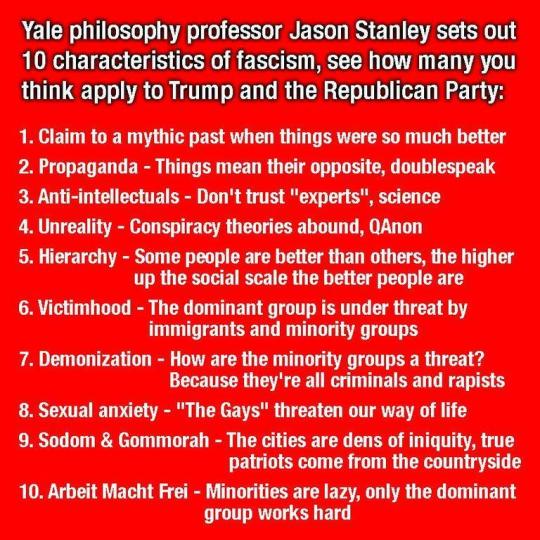
“Fascism is a creation of race hatred and its politically organized expression.” - Willhelm Reich, The Mass Psychology of Fascism (1933).
“Fascism is capitalism plus murder.” - Upton Sinclair
“Repression by brute force is always a confession of the inability to make use of the better weapons of the intellect — better because they alone give promise of final success. This is the fundamental error from which Fascism suffers and which will ultimately cause its downfall…that its foreign policy, based as it is on the avowed principle of force in international relations, cannot fail to give rise to an endless series of wars that must destroy all of modern civilization requires no further discussion. To maintain and further raise our present level of economic development, peace among nations must be assured. But they cannot live together in peace if the basic tenet of the ideology by which they are governed is the belief that one’s own nation can secure its place in the community of nations by force alone. ” - Ludwig von Mises, Liberalism: A Socio-Economic Exposition (1927).
“Spent most of the day reading fascisti leaflets. They certainly have turned the whole country into an army. From cradle to grave one is cast in the mould of fascismo and there can be no escape … It is certainly a socialist experiment in that it destroys individuality. It destroys liberty.” - Harold Nicolson, The Harold Nicolson Diaries : 1919-1964 (2004).
“The liberty of a democracy is not safe if the people tolerated the growth of private power to a point where it becomes stronger than the democratic state itself. That in its essence is fascism: ownership of government by an individual, by a group, or any controlling private power.” - Franklin D. Roosevelt
“A fascist is one whose lust for money or power is combined with such an intensity of intolerance toward those of other races, parties, classes, religions, cultures, regions or nations as to make him ruthless in his use of deceit or violence to attain his ends….If we define an American fascist as one who in case of conflict puts money and power ahead of human beings, then there are undoubtedly several million fascists in the United States.” - Henry A. Wallace
“Fascism is the cult of organised murder, invented by the arch-enemies of society. It tends to destroy civilization and revert man to his most barbarous state. Mussolini and Hitler might well be called the devils of an age, for they are playing hell with civilization.” - Marcus Garvey, Authors take Sides on the Spanish War, 1937 Philosophy Tube's breakdown of the elements of fascism is very thorough and recommended if you're not the reading type. But do you read books? We hope so if you're looking to engage in political discussion about anything. Here are some books that tackle the definition of fascism, in whole or in part, that we would recommend to you (check/order from your local library!) Mark Bray's highly-accessible Antifa: The Anti-Fascist Handbook is a great starting point for this topic.
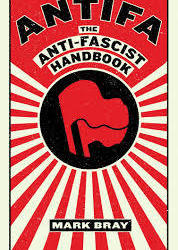
Columbia history professor Robert O. Paxton's excellent book The Anatomy of Fascism goes into this in great detail.
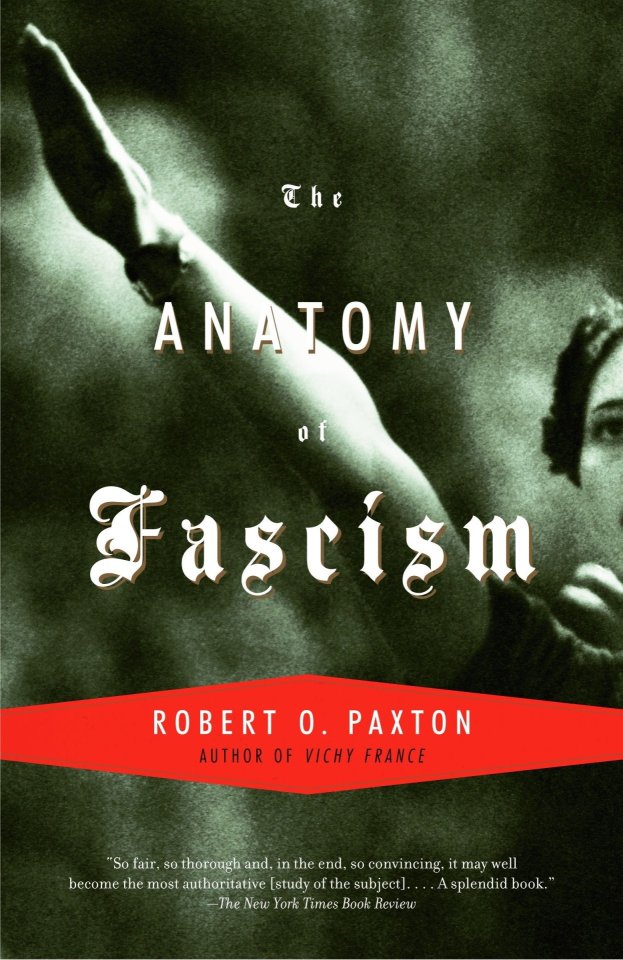
There's also Umberto Eco's The Eternal Fascist

or his "practical list for identifying fascists" as well as Hannah Arendt's seminal The Origins of Totalitarianism

We hope you weren't looking for a simple answer to the complex question of "what is fascism?" Anon, just as we hope you're up to taking our challenge of checking out all of the above so you're curiosity is satisfied and you're well-versed on the topic.
653 notes
·
View notes